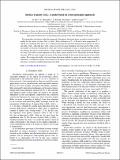| dc.contributor.author | Massobrio, C. | |
| dc.contributor.author | Bouzid, A. | |
| dc.contributor.author | Boero, M. | |
| dc.contributor.author | Ori, Guido | |
| dc.contributor.author | Coasne, Benoit Alain | |
| dc.date.accessioned | 2014-08-11T15:53:50Z | |
| dc.date.available | 2014-08-11T15:53:50Z | |
| dc.date.issued | 2014-07 | |
| dc.date.submitted | 2014-07 | |
| dc.identifier.issn | 1098-0121 | |
| dc.identifier.issn | 1550-235X | |
| dc.identifier.uri | http://hdl.handle.net/1721.1/88660 | |
| dc.description.abstract | First-principles calculations within the framework of the density functional theory are used to construct realistic models for the surface of glassy GeS[subscript 2](g−GeS[subscript 2]). Both calculations at T = 0 K and at finite temperature (T = 300 K) are considered. This allows for a comparison between the structural and electronic properties of surface and bulk g−GeS[subscript 2]. Although the g−GeS[subscript 2] surface recovers the main tetrahedral structural motif of bulk g−GeS[subscript 2], the number of fourfold coordinated Ge atoms and twofold coordinated S atoms is smaller than in the bulk. On the contrary, the surface system features a larger content of overcoordinated S atoms and threefold coordinated Ge atoms. This effect is more important for the g−GeS[subscript 2] surface relaxed at 0 K. Maximally localized Wannier functions (WF) are used to inspect the nature of the chemical bonds of the structural units present at the g−GeS[subscript 2] surface. We compare the ability of several charge derivation methods to capture the atomic charge variations induced by a coordination change. Our estimate for the charges allows exploiting the first-principles results as a data base to construct a reliable interatomic force field. | en_US |
| dc.publisher | American Physical Society | en_US |
| dc.relation.isversionof | http://dx.doi.org/10.1103/PhysRevB.90.045423 | en_US |
| dc.rights | Article is made available in accordance with the publisher's policy and may be subject to US copyright law. Please refer to the publisher's site for terms of use. | en_US |
| dc.source | American Physical Society | en_US |
| dc.title | Surface of glassy GeS[subscript 2]: A model based on a first-principles approach | en_US |
| dc.type | Article | en_US |
| dc.identifier.citation | Ori, G., C. Massobrio, A. Bouzid, M. Boero, and B. Coasne. “Surface of Glassy GeS[subscript 2]: A Model Based on a First-Principles Approach.” Phys. Rev. B 90, no. 4 (July 2014). © 2014 American Physical Society | en_US |
| dc.contributor.department | Massachusetts Institute of Technology. Department of Civil and Environmental Engineering | en_US |
| dc.contributor.mitauthor | Ori, Guido | en_US |
| dc.contributor.mitauthor | Coasne, Benoit Alain | en_US |
| dc.relation.journal | Physical Review B | en_US |
| dc.eprint.version | Final published version | en_US |
| dc.type.uri | http://purl.org/eprint/type/JournalArticle | en_US |
| eprint.status | http://purl.org/eprint/status/PeerReviewed | en_US |
| dc.date.updated | 2014-07-25T22:00:04Z | |
| dc.language.rfc3066 | en | |
| dc.rights.holder | American Physical Society | |
| dspace.orderedauthors | Ori, G.; Massobrio, C.; Bouzid, A.; Boero, M.; Coasne, B. | en_US |
| mit.license | PUBLISHER_POLICY | en_US |
| mit.metadata.status | Complete | |
